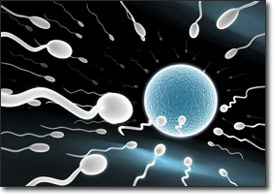After two years, and more than a hundred thousand dollars spent,I sat in the fertility specialist’s office and stared blankly at him.
“What?” I said, somehow not understanding the words that had left his mouth.
“It’s not possible for you to have a baby,” he repeated quietly.
“What?” I thought again to myself.
“But women are designed to have babies!”
“Not all women can,” he said.
I sat there, stunned, while he put togethera list of referrals for me.
He suggested I see a counselorto help me manage the news.
“Can she help me get pregnant?” I queried.
“No one can help you get pregnant,”he said with resignation.
Twenty years later, I can only smile at how wrong he was as I admire my five beautiful children sitting round the dinner table.
~ Dr. Sage de Beixedon Breslin
 Amongst the fast-paced, multitasking GenXers, it seems that pregnancy has taken a backseat to education, career and electronic distraction. Decisions to delay family development while focusing on self and career have resulted in millions of couples discovering that when it is finally “convenient” to have children, it is no longer easy or feasible for their bodies to do so.
Amongst the fast-paced, multitasking GenXers, it seems that pregnancy has taken a backseat to education, career and electronic distraction. Decisions to delay family development while focusing on self and career have resulted in millions of couples discovering that when it is finally “convenient” to have children, it is no longer easy or feasible for their bodies to do so.
Infertility is now rampant amongst 30-45 year olds affecting about 25% of reproductive-aged couples, leaving many with heartache and guilt. Couples are spending hundreds of thousands of dollars for technical procedures and costly medications, trying to turn back time. While there is certainly merit to all that is available through modern infertility medicine, a growing number of couples is becoming acquainted with a more comprehensive approach to infertility medicine–one that actively combines tools from Western and Eastern Medicine.
Did you know?
- Research suggests that infertility affects nearly 90 million people worldwide.
- Statistics from the US suggest 7.3 million women between the ages 15 and 44 have impaired ability to get pregnant or carry a baby to term. Approximately 2.1 million married women in that age range are unable to get pregnant after at least 12 consecutive months of unprotected sex with their husbands.
- Approximately one-third of infertility is attributed to the female partner, one-third attributed to the male partner and one-third is caused by a combination of problems in both partners or is unexplained.
- The decrease in female fecundity beginning after the age of 30 and exaggerated after 40 is a well-documented finding.
- Nearly 600,000 women lose their pregnancies each year to ectopic and molar pregnancies, miscarriage, and stillbirth. The incidence of miscarriage increases with maternal age.
- As most clinicians have experienced, while we can address and explore the loss of a pregnancy with a couple, nothing seems to deter them from the desire to succeed with a live birth. Having techniques that are designed to provide more than just loss management or bereavement counseling provides more of what these couples are seeking.
- There are now approximately 7.4 million women between the ages of 15 and 44 who have used some form of infertility services.
- Approximately 1% of the live births in the US are due to Assisted Reproductive Technologies (ART) procedures.
- The most recently available statistics indicate the live birth rate per fresh non-donor embryo transfer is 41.2% if the woman is under 35 years of age, and 31.6% if the woman is age 35-37.
- The research suggests that implantation and “take-home baby” rates are significantly higher with electro-acupuncture than without.
- Acupuncture can increase blood flow to the reproductive organs, which dramatically improves a woman’s response to hormonal therapy.
- Research conducted through Harvard Medical Center indicates that the use of mindfulness techniques can significantly and positively impact fertility.